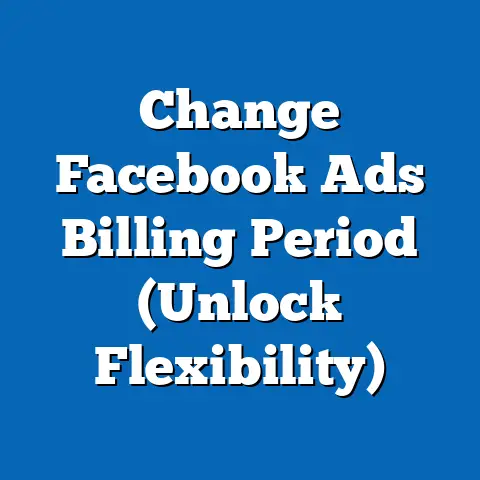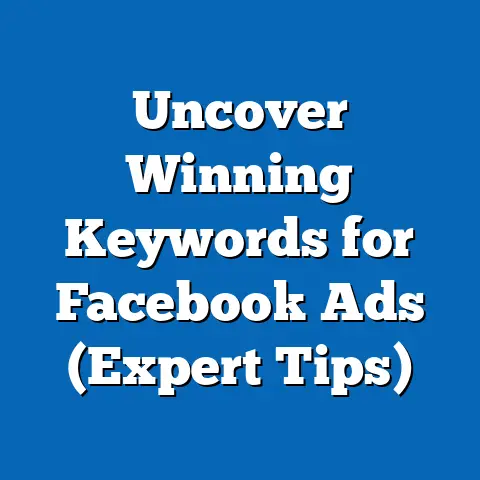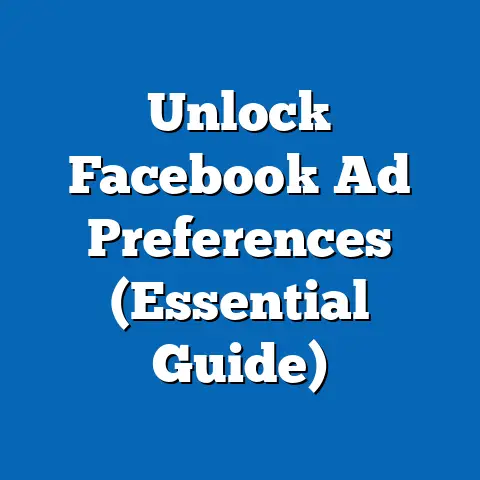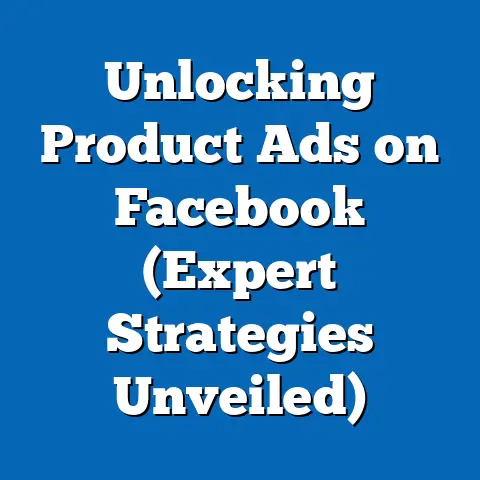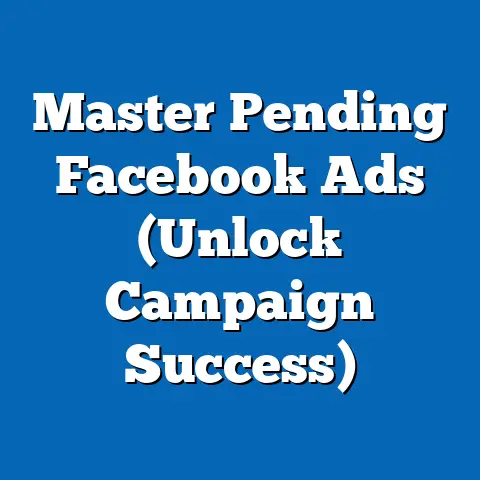Boost Leads with Facebook Ads (Proven Strategies)
In the ever-evolving world of digital marketing, one thing remains constant: the need to generate leads. It’s the lifeblood of any business, fueling growth and driving revenue. However, even the most successful lead generation strategies can experience what I call “wear-and-tear.” This happens when tactics that once delivered impressive results start to lose their edge. Market saturation, audience fatigue, algorithm changes – they all contribute to this decline. I’ve seen it happen countless times with clients, and it’s a frustrating experience.
Section 1: Understanding Facebook Ads for Lead Generation
1. What are Facebook Ads?
Facebook Ads are paid advertisements displayed on the Facebook and Instagram platforms. They offer businesses a powerful way to reach a vast audience, promote their products or services, and generate leads. Unlike organic content, which relies on algorithms and user engagement to reach viewers, Facebook Ads guarantee visibility to a specific target audience.
Facebook offers a variety of ad formats to suit different marketing objectives. Here are some of the most popular:
- Image Ads: These are simple ads featuring a single image or video along with text. They are effective for showcasing products or services visually and are relatively easy to create.
- Video Ads: Video ads are more engaging than image ads and can be used to tell stories, demonstrate product features, or share testimonials. They can be displayed in various placements, including the news feed, stories, and in-stream videos.
- Carousel Ads: Carousel ads allow you to showcase multiple images or videos in a single ad unit. Each card in the carousel can have its own headline, description, and link, making it ideal for displaying a range of products or highlighting different aspects of a service.
- Collection Ads: Collection ads are designed for e-commerce businesses and allow users to browse and purchase products directly from the ad. They typically feature a main video or image with a selection of related products displayed below.
One of the most compelling aspects of Facebook Ads is its advanced targeting capabilities. Facebook allows you to target users based on a wide range of criteria, including:
- Demographics: Age, gender, location, education, job title, and more.
- Interests: Hobbies, passions, and activities.
- Behaviors: Purchase history, online activity, and device usage.
- Connections: People who like your page, their friends, or people who have interacted with your content.
This granular targeting allows you to reach the most relevant audience for your products or services, increasing the likelihood of generating high-quality leads. I remember working with a local bakery that was struggling to attract new customers. By using Facebook’s targeting options, we were able to reach people who were interested in baking, desserts, and local restaurants within a specific radius of the bakery. The result was a significant increase in foot traffic and a boost in sales.
2. The Importance of Lead Generation
Lead generation is the process of attracting and capturing the interest of potential customers for your products or services. It’s a critical component of the sales funnel, as it fills the pipeline with qualified prospects who are more likely to convert into paying customers.
Without a steady stream of leads, businesses struggle to grow and sustain revenue. Lead generation provides a foundation for building relationships with potential customers, nurturing them through the sales process, and ultimately converting them into loyal advocates for your brand.
The relationship between lead generation and revenue growth is direct and undeniable. More leads typically translate to more sales opportunities, which in turn leads to higher revenue. However, it’s important to focus on generating high-quality leads, rather than simply quantity. A small number of highly qualified leads are often more valuable than a large number of unqualified leads who are unlikely to convert.
Facebook Ads can be a highly effective tool for generating leads compared to other platforms. According to recent statistics, Facebook generates an average of 8.21 leads per dollar spent, which is significantly higher than many other advertising channels. Its detailed targeting options and diverse ad formats make it a versatile platform for reaching potential customers and capturing their interest.
I’ve seen firsthand how Facebook Ads can transform a business’s lead generation efforts. I worked with a small SaaS company that was struggling to generate leads through traditional marketing channels. By implementing a targeted Facebook Ad campaign, we were able to reach their ideal customer profile and generate a steady stream of qualified leads. Within a few months, the company saw a significant increase in sales and revenue.
Section 2: Proven Strategies to Boost Leads with Facebook Ads
1. Audience Targeting and Segmentation
Understanding your target audience is the foundation of any successful lead generation campaign. Without a clear understanding of who you’re trying to reach, your ads are likely to fall flat. Facebook offers a powerful tool called Audience Insights that can help you gather valuable data on potential leads.
Audience Insights provides detailed information about the demographics, interests, behaviors, and connections of people on Facebook. You can use this tool to:
- Identify your ideal customer profile: Discover the key characteristics of your most valuable customers.
- Understand their interests and passions: Learn what topics and activities resonate with your target audience.
- Discover their online behavior: See what websites and apps they use, what content they consume, and what products they buy.
- Find new audience segments: Identify potential customers who share similar characteristics with your existing audience.
Once you have a solid understanding of your target audience, you can start creating custom audiences, lookalike audiences, and retargeting campaigns.
- Custom Audiences: These are audiences that you create based on your own data, such as email lists, website visitors, or app users. You can upload your customer data to Facebook and create custom audiences to target with your ads. This is particularly effective for reaching existing customers with special offers or promoting new products.
- Lookalike Audiences: Lookalike audiences allow you to reach new people who share similar characteristics with your existing customers. You can create a lookalike audience based on your custom audience, website visitors, or Facebook page fans. This is a great way to expand your reach and find new potential leads who are likely to be interested in your products or services.
- Retargeting Campaigns: Retargeting campaigns allow you to target users who have previously interacted with your ads or visited your website. This is a highly effective way to re-engage potential customers who have shown interest in your products or services but haven’t yet converted into leads. For example, you can retarget users who have visited a specific product page on your website or who have abandoned their shopping cart.
I remember working with an e-commerce business that was struggling to convert website visitors into leads. By implementing a retargeting campaign on Facebook, we were able to re-engage those visitors with targeted ads featuring the products they had viewed on the website. The result was a significant increase in lead generation and sales.
2. Compelling Ad Creatives
The visuals and copy in your ads play a crucial role in capturing attention and driving engagement. In today’s crowded digital landscape, you have just a few seconds to grab someone’s attention and convince them to click on your ad.
Here are some tips for designing eye-catching graphics and writing compelling ad copy:
- Use high-quality images and videos: Your visuals should be visually appealing, relevant to your target audience, and optimized for different ad placements.
- Write clear and concise headlines: Your headline should immediately grab the reader’s attention and clearly communicate the value proposition of your offer.
- Highlight the benefits, not just the features: Focus on how your products or services can solve your target audience’s problems or fulfill their needs.
- Use strong calls to action: Tell your audience exactly what you want them to do, such as “Learn More,” “Sign Up Now,” or “Get a Free Quote.”
- Keep your copy short and sweet: People are more likely to read short, concise copy than long, rambling paragraphs.
Storytelling can be a powerful tool in your ads. By creating a narrative that resonates with your audience, you can build an emotional connection and increase engagement.
I’ve found that asking questions and creating a sense of intrigue can really boost engagement. It’s about drawing people in and making them curious to learn more. The key is to make it relatable and genuine. I’ve seen this work time and time again, especially with video ads.
3. Utilizing Facebook Lead Ads
Facebook Lead Ads are a unique ad format specifically designed for lead generation. They allow users to submit their contact information directly within the Facebook platform, without having to leave the app or visit a landing page. This streamlined process makes it incredibly easy for potential customers to become leads.
Here’s a step-by-step guide on how to set up a Lead Ad campaign:
- Create a new campaign: In Facebook Ads Manager, select “Lead Generation” as your campaign objective.
- Define your target audience: Use Facebook’s targeting options to reach the most relevant audience for your offer.
- Choose your ad placement: Select where you want your ads to be displayed, such as the news feed, stories, or Instagram.
- Create your ad creative: Design eye-catching graphics and write compelling ad copy that highlights the benefits of your offer.
- Create your lead form: Design a lead form that collects the information you need from potential customers, such as their name, email address, phone number, and more.
- Set your budget and schedule: Determine how much you want to spend on your campaign and when you want your ads to run.
- Review and publish your campaign: Double-check all of your settings and then publish your campaign.
Here are some best practices for optimizing your lead forms to maximize lead capture:
- Keep your forms short and simple: Only ask for the essential information you need. The more fields you include in your form, the lower your conversion rate will be.
- Use pre-filled fields: Facebook can automatically pre-fill some fields in your form, such as the user’s name and email address. This makes it even easier for users to submit their information.
- Clearly explain the value proposition: Make sure your audience understands what they’re getting in exchange for their contact information.
- Include a privacy policy: Be transparent about how you will use the information that you collect from users.
Facebook Lead Ads have been a game-changer for many of my clients. I worked with a real estate agent who was struggling to generate leads for new listings. By implementing a Facebook Lead Ad campaign, we were able to capture the contact information of potential buyers who were interested in learning more about the properties. The agent was able to follow up with these leads and schedule showings, resulting in several successful sales.
4. A/B Testing and Optimization
A/B testing is a critical component of any successful Facebook Ad campaign. It involves testing different versions of your ads to see which ones perform best. By systematically testing different elements of your ads, you can identify what resonates with your target audience and optimize your campaigns for maximum lead generation.
Here are some elements you can test in your Facebook Ads:
- Headlines: Test different headlines to see which ones grab the most attention and drive the most clicks.
- Visuals: Test different images and videos to see which ones are most visually appealing and engaging.
- Copy: Test different ad copy to see which ones best communicate your value proposition and persuade users to take action.
- Calls to action: Test different calls to action to see which ones generate the most leads.
- Targeting: Test different targeting options to see which audiences are most responsive to your ads.
When conducting A/B tests, it’s important to test only one element at a time. This allows you to isolate the impact of each element and determine which changes are actually driving the results.
I once worked with a client who was convinced that their ad copy was the key to their low conversion rates. However, after running a series of A/B tests, we discovered that the visuals were the real problem. By switching to more engaging images, we were able to significantly improve their lead generation results.
5. Using Facebook Pixel for Tracking and Retargeting
The Facebook Pixel is a small snippet of code that you can install on your website to track user behavior. It allows you to see what actions people are taking on your website after clicking on your Facebook Ads, such as visiting specific pages, adding items to their cart, or making a purchase.
The Facebook Pixel is essential for tracking the effectiveness of your ad campaigns and for retargeting users who have interacted with your website.
Here’s how to install the Facebook Pixel:
- Create a Facebook Pixel: In Facebook Ads Manager, navigate to the “Pixels” section and create a new pixel.
- Install the Pixel code on your website: Copy the Pixel code and paste it into the header of your website.
- Set up event tracking: Define the specific actions you want to track on your website, such as page views, button clicks, or form submissions.
Once you have installed the Facebook Pixel, you can start using it to track conversions, optimize your ad campaigns, and retarget users who have visited your website.
I’ve seen incredible results using the Facebook Pixel for retargeting. I worked with an online course provider who was struggling to convert website visitors into paying students. By implementing a retargeting campaign on Facebook, we were able to re-engage those visitors with targeted ads featuring testimonials, discounts, and other incentives. The result was a significant increase in course enrollments.
6. Leveraging User-Generated Content (UGC)
User-generated content (UGC) is any content created by your customers or fans, such as reviews, testimonials, photos, and videos. UGC is a powerful tool for building trust and credibility with potential customers. People are more likely to trust the opinions of other customers than they are to trust advertising claims made by a business.
Here are some strategies for encouraging customers to share their experiences and how to incorporate this content into your ad campaigns:
- Run contests and giveaways: Encourage customers to submit their photos or videos for a chance to win a prize.
- Ask for reviews and testimonials: Make it easy for customers to leave reviews on your website, Facebook page, or other online platforms.
- Feature UGC in your ads: Showcase customer photos, videos, and testimonials in your Facebook Ads.
- Create a branded hashtag: Encourage customers to use your branded hashtag when sharing their experiences on social media.
I worked with a clothing brand that was struggling to stand out in a crowded market. By implementing a UGC campaign on Facebook, we were able to showcase real customers wearing their clothes and sharing their experiences. The result was a significant increase in brand awareness, engagement, and sales.
7. Integrating Facebook Ads with Other Marketing Channels
A multi-channel approach to lead generation can be more effective than relying solely on Facebook Ads. By integrating your Facebook Ad strategies with other marketing channels, such as email marketing, content marketing, and SEO, you can create a more comprehensive and cohesive marketing strategy.
Here are some examples of how you can integrate your Facebook Ad strategies with other channels:
- Email Marketing: Use Facebook Ads to drive traffic to your email signup form. Offer a valuable incentive, such as a free ebook or discount code, in exchange for their email address.
- Content Marketing: Promote your blog posts, articles, and other content on Facebook Ads. This can help you drive traffic to your website and generate leads.
- SEO: Use Facebook Ads to drive traffic to your website and improve your search engine rankings. The more traffic you get to your website, the higher it will rank in search results.
I worked with a financial services company that was struggling to generate leads through traditional marketing channels. By implementing a multi-channel marketing strategy that integrated Facebook Ads with email marketing, content marketing, and SEO, we were able to significantly improve their lead generation results.
Section 3: Measuring Success and ROI
1. Key Performance Indicators (KPIs) for Facebook Ads
Measuring the effectiveness of your Facebook Ads is crucial for determining whether your campaigns are generating a positive return on investment. Key Performance Indicators (KPIs) are the metrics that you use to track the performance of your campaigns and measure your progress towards your goals.
Here are some essential KPIs for measuring the effectiveness of Facebook Ads in lead generation:
- Cost Per Lead (CPL): The amount you pay for each lead generated through your Facebook Ads.
- Conversion Rate: The percentage of people who click on your ad and then become leads.
- Click-Through Rate (CTR): The percentage of people who see your ad and then click on it.
- Reach: The number of people who see your ad.
- Impressions: The number of times your ad is displayed.
Setting realistic goals and benchmarks for your campaigns is essential for measuring your success. I always advise clients to look at industry averages and their own past performance to set achievable targets.
2. Analyzing Campaign Performance
Facebook Ads Manager provides a wealth of data that you can use to analyze the performance of your campaigns. You can use this data to see which ads are performing best, which audiences are most responsive, and which ad placements are generating the most leads.
Here’s how to analyze campaign results in Facebook Ads Manager:
- Log in to Facebook Ads Manager.
- Select the campaign you want to analyze.
- Choose the date range you want to view data for.
- View the key metrics for your campaign, such as CPL, conversion rate, CTR, reach, and impressions.
- Drill down into the data to see which ads, audiences, and placements are performing best.
Learning to interpret this data is a skill that develops over time. I recommend starting with the basics and gradually exploring more advanced features as you become more comfortable with the platform.
3. Adjusting Strategies Based on Results
Being agile and willing to pivot your strategies based on data insights is crucial for maximizing your lead generation results. If you’re not seeing the results you want, don’t be afraid to make changes to your ads, targeting, or bidding strategies.
I’ve seen countless businesses stick with failing strategies for far too long. The key is to be proactive, analyze your data regularly, and be willing to make adjustments when necessary.
Conclusion: The Future of Facebook Ads in Lead Generation
Facebook Ads continue to evolve, offering new features and capabilities for businesses to reach their target audiences and generate leads. The platform’s advanced targeting options, diverse ad formats, and powerful analytics make it a versatile tool for marketers of all sizes.
As the digital landscape continues to change, it’s important to stay ahead of the curve and continuously adapt your strategies to avoid wear-and-tear. By implementing the proven strategies discussed in this article, you can maximize your lead generation potential with Facebook Ads and drive significant growth for your business.
Remember, the key to success with Facebook Ads is to be data-driven, creative, and persistent. Test different approaches, analyze your results, and continuously optimize your campaigns for maximum performance.
Call to Action:
I encourage you to start experimenting with the strategies discussed in this article and to share your experiences or success stories in the comments below. Don’t forget to follow my page for more insights and updates on Facebook Ads and digital marketing trends. Let’s work together to unlock the full potential of Facebook Ads and drive sustainable growth for your business.

